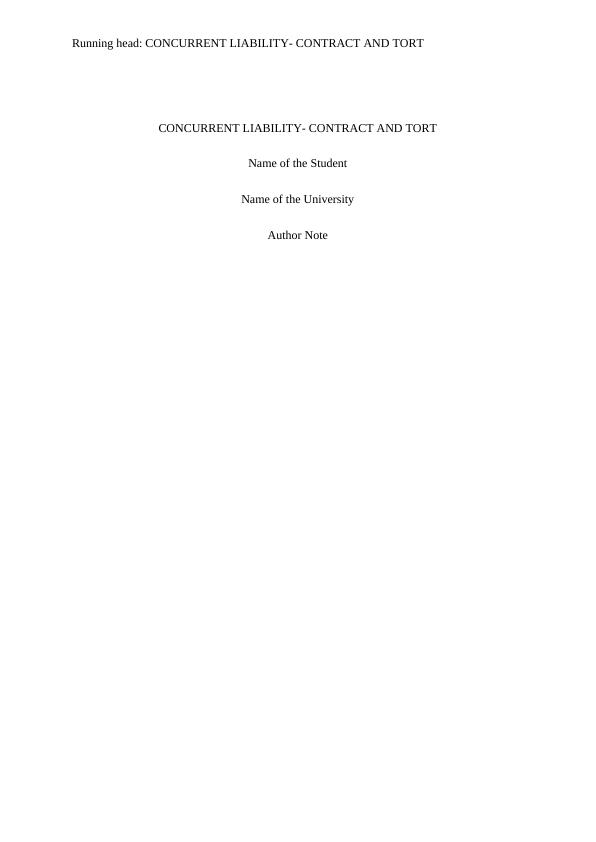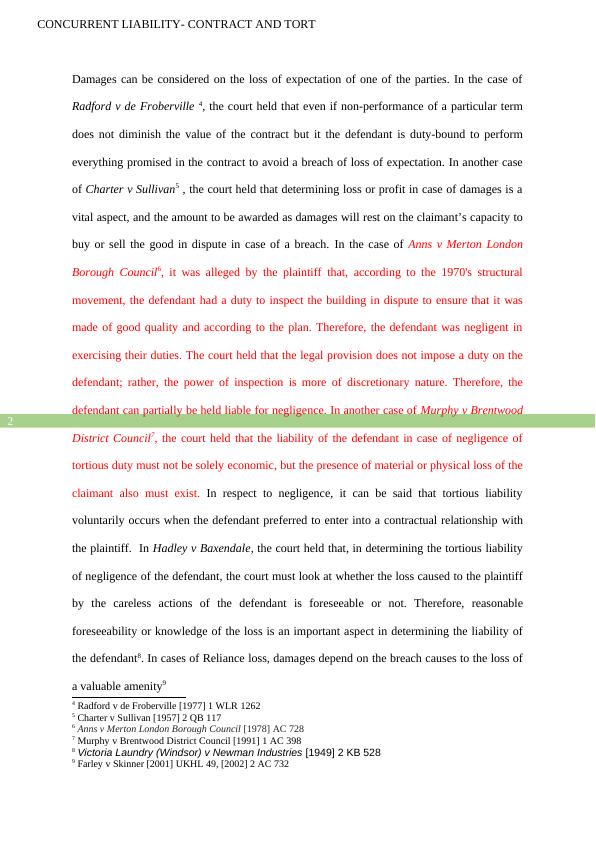Concurrent Liability - Contract and Tort
Added on 2022-08-22
9 Pages2371 Words23 Views
Running head: CONCURRENT LIABILITY- CONTRACT AND TORT
CONCURRENT LIABILITY- CONTRACT AND TORT
Name of the Student
Name of the University
Author Note
CONCURRENT LIABILITY- CONTRACT AND TORT
Name of the Student
Name of the University
Author Note

CONCURRENT LIABILITY- CONTRACT AND TORT
1
Concurrent liability is an English law doctrine by which a defendant can be held liable
under more than one rule of law. Similarly, defendants are also liable to give a proportionate
share to the plaintiff. It is defined as a connection between two simultaneous private law
duties. Concurrent liability can be attracted under both the contract law and Law of torts. The
conflict arises while determining damages in cases that have the attributes of both the
contract and tort. Sometimes the plaintiff asks for damages under the law of contract, but the
defendant claims to consider the case under the tortious liability1. In determining concurrent
cases, courts mostly prefer to consider the presence of tortious liability. This is because most
of the tort liabilities are accountable under the act of negligence. By considering the act of
negligence as a claim, the court measures the duty of care to decide the liability of the
plaintiff to get damages for negligence. This study will mainly scrutinize the cases where a
careless breach of contract may give rise to concurrent liability under the law of contract and
law of tort.
Under the common law, various judgments of the court of law stated that, where the
parties are already under a contractual relationship, there is no scope for tortious liability in
the same case and parties had the discretion to choose between a contractual tortious liability
where both of the attributes are present in a case. However, the plaintiff is bound to present
all related particulars of the case by filing a complaint stating his or her rights against the
defendant2. A claim for damages can arise by either the breach of a contractual duty or
tortious liability. In the case of Robinson v Harman, the court held that the motive of
providing damages is to bring back the plaintiff in the same place where they could have been
if the contract was honored3. Nowadays, the applicability of the 'incident rule' with respect to
the concurrent liability calculating the remoteness of damages is flawed and unpredictable.
1 Cheshire, Fifoot & Furmston’s Law of Contract (Furmston, 2017)
2 C & P Haulage v Middleton [1983] 1 WLR 1461.
3 Robinson v Harman (1848) 1 Exch 850
1
Concurrent liability is an English law doctrine by which a defendant can be held liable
under more than one rule of law. Similarly, defendants are also liable to give a proportionate
share to the plaintiff. It is defined as a connection between two simultaneous private law
duties. Concurrent liability can be attracted under both the contract law and Law of torts. The
conflict arises while determining damages in cases that have the attributes of both the
contract and tort. Sometimes the plaintiff asks for damages under the law of contract, but the
defendant claims to consider the case under the tortious liability1. In determining concurrent
cases, courts mostly prefer to consider the presence of tortious liability. This is because most
of the tort liabilities are accountable under the act of negligence. By considering the act of
negligence as a claim, the court measures the duty of care to decide the liability of the
plaintiff to get damages for negligence. This study will mainly scrutinize the cases where a
careless breach of contract may give rise to concurrent liability under the law of contract and
law of tort.
Under the common law, various judgments of the court of law stated that, where the
parties are already under a contractual relationship, there is no scope for tortious liability in
the same case and parties had the discretion to choose between a contractual tortious liability
where both of the attributes are present in a case. However, the plaintiff is bound to present
all related particulars of the case by filing a complaint stating his or her rights against the
defendant2. A claim for damages can arise by either the breach of a contractual duty or
tortious liability. In the case of Robinson v Harman, the court held that the motive of
providing damages is to bring back the plaintiff in the same place where they could have been
if the contract was honored3. Nowadays, the applicability of the 'incident rule' with respect to
the concurrent liability calculating the remoteness of damages is flawed and unpredictable.
1 Cheshire, Fifoot & Furmston’s Law of Contract (Furmston, 2017)
2 C & P Haulage v Middleton [1983] 1 WLR 1461.
3 Robinson v Harman (1848) 1 Exch 850

CONCURRENT LIABILITY- CONTRACT AND TORT
2
Damages can be considered on the loss of expectation of one of the parties. In the case of
Radford v de Froberville 4, the court held that even if non-performance of a particular term
does not diminish the value of the contract but it the defendant is duty-bound to perform
everything promised in the contract to avoid a breach of loss of expectation. In another case
of Charter v Sullivan5 , the court held that determining loss or profit in case of damages is a
vital aspect, and the amount to be awarded as damages will rest on the claimant’s capacity to
buy or sell the good in dispute in case of a breach. In the case of Anns v Merton London
Borough Council6, it was alleged by the plaintiff that, according to the 1970's structural
movement, the defendant had a duty to inspect the building in dispute to ensure that it was
made of good quality and according to the plan. Therefore, the defendant was negligent in
exercising their duties. The court held that the legal provision does not impose a duty on the
defendant; rather, the power of inspection is more of discretionary nature. Therefore, the
defendant can partially be held liable for negligence. In another case of Murphy v Brentwood
District Council7, the court held that the liability of the defendant in case of negligence of
tortious duty must not be solely economic, but the presence of material or physical loss of the
claimant also must exist. In respect to negligence, it can be said that tortious liability
voluntarily occurs when the defendant preferred to enter into a contractual relationship with
the plaintiff. In Hadley v Baxendale, the court held that, in determining the tortious liability
of negligence of the defendant, the court must look at whether the loss caused to the plaintiff
by the careless actions of the defendant is foreseeable or not. Therefore, reasonable
foreseeability or knowledge of the loss is an important aspect in determining the liability of
the defendant8. In cases of Reliance loss, damages depend on the breach causes to the loss of
a valuable amenity9
4 Radford v de Froberville [1977] 1 WLR 1262
5 Charter v Sullivan [1957] 2 QB 117
6 Anns v Merton London Borough Council [1978] AC 728
7 Murphy v Brentwood District Council [1991] 1 AC 398
8 Victoria Laundry (Windsor) v Newman Industries [1949] 2 KB 528
9 Farley v Skinner [2001] UKHL 49, [2002] 2 AC 732
2
Damages can be considered on the loss of expectation of one of the parties. In the case of
Radford v de Froberville 4, the court held that even if non-performance of a particular term
does not diminish the value of the contract but it the defendant is duty-bound to perform
everything promised in the contract to avoid a breach of loss of expectation. In another case
of Charter v Sullivan5 , the court held that determining loss or profit in case of damages is a
vital aspect, and the amount to be awarded as damages will rest on the claimant’s capacity to
buy or sell the good in dispute in case of a breach. In the case of Anns v Merton London
Borough Council6, it was alleged by the plaintiff that, according to the 1970's structural
movement, the defendant had a duty to inspect the building in dispute to ensure that it was
made of good quality and according to the plan. Therefore, the defendant was negligent in
exercising their duties. The court held that the legal provision does not impose a duty on the
defendant; rather, the power of inspection is more of discretionary nature. Therefore, the
defendant can partially be held liable for negligence. In another case of Murphy v Brentwood
District Council7, the court held that the liability of the defendant in case of negligence of
tortious duty must not be solely economic, but the presence of material or physical loss of the
claimant also must exist. In respect to negligence, it can be said that tortious liability
voluntarily occurs when the defendant preferred to enter into a contractual relationship with
the plaintiff. In Hadley v Baxendale, the court held that, in determining the tortious liability
of negligence of the defendant, the court must look at whether the loss caused to the plaintiff
by the careless actions of the defendant is foreseeable or not. Therefore, reasonable
foreseeability or knowledge of the loss is an important aspect in determining the liability of
the defendant8. In cases of Reliance loss, damages depend on the breach causes to the loss of
a valuable amenity9
4 Radford v de Froberville [1977] 1 WLR 1262
5 Charter v Sullivan [1957] 2 QB 117
6 Anns v Merton London Borough Council [1978] AC 728
7 Murphy v Brentwood District Council [1991] 1 AC 398
8 Victoria Laundry (Windsor) v Newman Industries [1949] 2 KB 528
9 Farley v Skinner [2001] UKHL 49, [2002] 2 AC 732

End of preview
Want to access all the pages? Upload your documents or become a member.
Related Documents
Legal Issues in Business Organizations Tourism and Events Organizations Assessment for 2021lg...
|8
|2481
|370
Claiming Damages for Negligence in Contract Lawlg...
|5
|685
|40
Tort of Negligence: Liability of Australian Post Employees and Financial Adviserlg...
|9
|2002
|417
Understanding Tort Law and Liability in Common Law Systemlg...
|5
|1518
|377
Assignment On Contract Law & Common Law - Breach Of RIghtslg...
|10
|3515
|141
Liability for Economic Loss Arises in Negligence Cases Using Case Lawlg...
|6
|1651
|470
